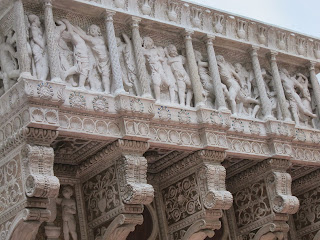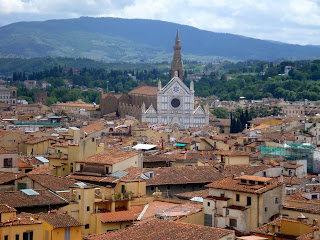Tuscany includes all the roads for motorcycle riding one might want to try, with interesting sights for all periods of history along the way. Our visit to spectacular Firenza of unfortunately only one day was in late May, so we could enjoy the culture with our visitors. We arrived to Firenza by train and purchased a pass that covered many of the museums and sights. The pass was good for three days, but we were limited to one as our guests were sadly to leave. We walked all day with needed stops for cafe and excellent food both on the street and restaurant. Exhaused, but with a taste of the city we four returned to the villa. Elisabetta was very clear that we had not touched the surface. Her love for, and sharing of her intimate knowledge of the city was one of our highlights, though she did not accompany us, busy as she was at that time of year in her vineyards.
Florence is a city contested for control by Rome, and by powerful neighbors such as Siena and Voltera and other invaders throughout its turbulent history. Florence enjoys a location on the Arno River on a trade route between Rome and France.
The works of art of the many Renaisance artists have been cared for by an enlightened populace and preserved over time to make Firenza the second most important city for arts and viewing after Roma according to travel writers.
The historically significant and powerful family of Medici and other individuals such as Prior Girmolano Savanarola, whose "Bonfire of the Vanities"- burning in the Palazza Vecchio of books, gaming tables, fine dresses, as well as works by poets in 1498 was stopped when he was burned at the stake. A commemorative bronze plaque is embedded near the Neptune Fountain in the Palazza.
Today, as important as the art and architecture of Florence is to bringing in tourists to the city, the cities infrastructure; restaurants and accommodation, easy transportation, keep them coming back. We four, in our whirlwind one day visit, were overwhelmed, leaving many reasons to someday return.
Renaissance [edit source]
copied from Wikopedia- for more extensive historical, cultural information see the history of florence in wiki
Of a population estimated at 80,000 before the Black Death of 1348, about 25,000 are said to have been supported by the city's woolen industry: in 1345 Florence was the scene of an attempted strike by wool carders (ciompi), who in 1378 rose up in a brief revolt against oligarchic rule in the Revolt of the Ciompi. After their suppression, the city came under the sway (1382–1434) of the Albizzi family, bitter rivals of the Medici. Cosimo de' Medici was the first Medici family member to essentially control the city from behind the scenes. Although the city was technically a democracy of sorts, his power came from a vast patronage network along with his alliance to the new immigrants, the gente nuova. The fact that the Medici were bankers to the pope also contributed to their rise. Cosimo was succeeded by his son Piero di Cosimo de' Medici, who was shortly thereafter succeeded by Cosimo's grandson, Lorenzo in 1469. Lorenzo was a great patron of the arts, commissioning works by Michelangelo, Leonardo da Vinci and Botticelli.
After Lorenzo's death in 1492, his son Piero took the reins of government, however his rule proved brief when in 1494 Charles VIII of France invaded Italy, entering Tuscany on his way to claim the throne of Naples. After Piero made a submissive treaty with Charles, the Florentines responded by forcing Piero into exile, and the first period of Medici rule ended with the restoration of a republican government. Anti-Medici sentiment was much influenced by the teachings of the radical Dominican prior Girolamo Savonarola. However, in due time, Savonarola lost support and was burned at the stake in 1498.
A second individual of unusual insight was Niccolò Machiavelli, whose prescriptions for Florence's regeneration under strong leadership have often been seen as a legitimization of political expediency and even malpractice. Commissioned by the Medici, Machiavelli wrote the Florentine Histories, the history of the city. However, Machiavelli was actually tortured and exiled from Florence by the Medici family and the Pope under the pretense of sedition due to his ties to the previous democratic government of Florence and the fact that his work threatened to expose the true nature of their power base and they wished to discredit him. The Florentines drove out the Medici for a second time and re-established a republic on May 16, 1527.
The 10-month Siege of Florence (1529–1530) by the Spanish ended the Republic of Florence as Alessandro de' Medici became the ruler of the city. The siege brought the destruction of its suburbs, the ruin of its export business and the confiscation of its citizens' wealth.[1]
Restored twice with the support of both Emperor and Pope, the Medici in 1537 became hereditary dukes of Florence, and in 1569 they became the Grand Dukes of Tuscany, ruling for two centuries. After the conquest of Siena, the city's historical rival, only the Republic of Lucca (later a Duchy) was independent from Florence in all Tuscany.
There was also a darker side to the Renaissance of Florence. Mobs were both common and influential. Families were pitted against each other in a constant struggle for power. Politically, double-crossings and betrayals were not uncommon, sometimes even within families. Despite political violence, factionalism and corruption, Renaissance Florence did experiment with different forms of citizen government and power sharing arrangements.



























































No comments:
Post a Comment